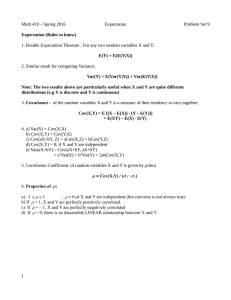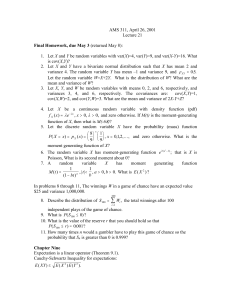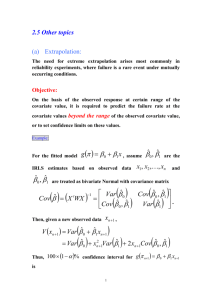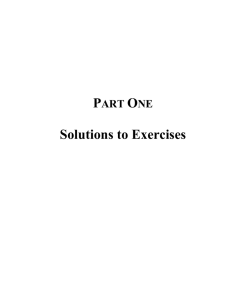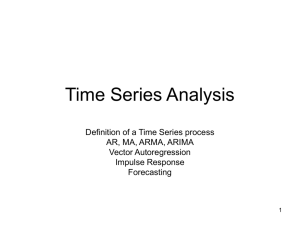Approximations for Mean and Variance of a Ratio
advertisement
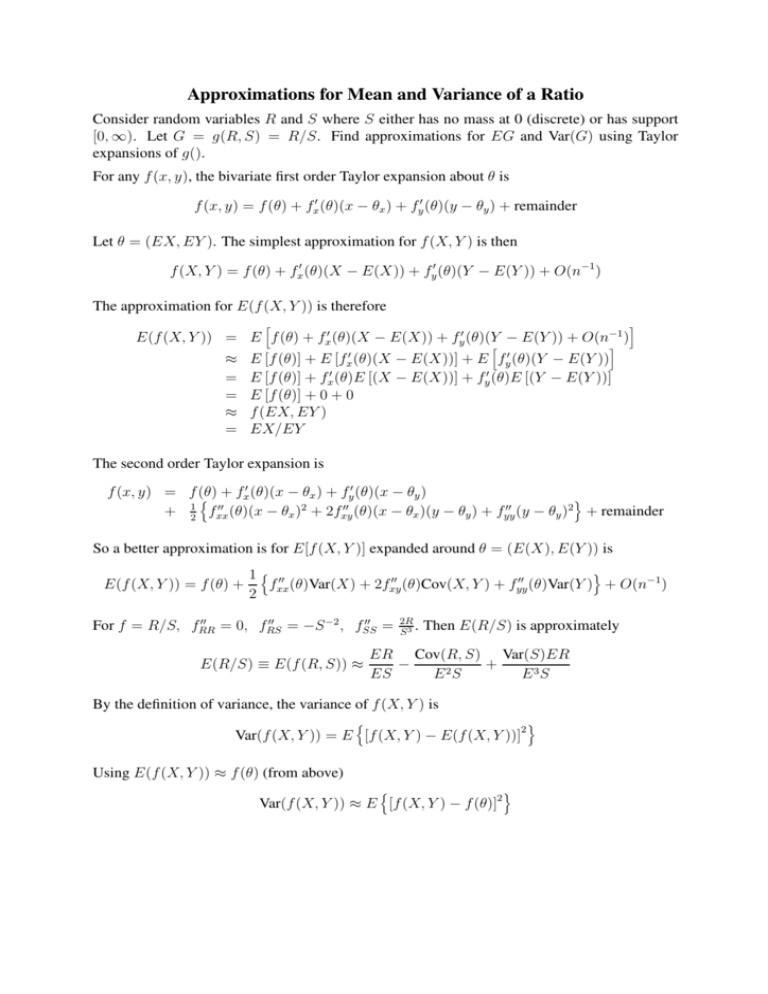
Approximations for Mean and Variance of a Ratio Consider random variables R and S where S either has no mass at 0 (discrete) or has support [0, ∞). Let G = g(R, S) = R/S. Find approximations for EG and Var(G) using Taylor expansions of g(). For any f (x, y), the bivariate first order Taylor expansion about θ is f (x, y) = f (θ) + fx′ (θ)(x − θx ) + fy′ (θ)(y − θy ) + remainder Let θ = (EX, EY ). The simplest approximation for f (X, Y ) is then f (X, Y ) = f (θ) + fx′ (θ)(X − E(X)) + fy′ (θ)(Y − E(Y )) + O(n−1) The approximation for E(f (X, Y )) is therefore E(f (X, Y )) = ≈ = = ≈ = h E f (θ) + fx′ (θ)(X − E(X)) + fy′ (θ)(Y − E(Y )) + O(n−1 ) h i E [f (θ)] + E [fx′ (θ)(X − E(X))] + E fy′ (θ)(Y − E(Y )) E [f (θ)] + fx′ (θ)E [(X − E(X))] + fy′ (θ)E [(Y − E(Y ))] E [f (θ)] + 0 + 0 f (EX, EY ) EX/EY i The second order Taylor expansion is ′ ′ f (x, y) = f (θ) o n + fx (θ)(x − θx ) + fy (θ)(x − θy ) ′′ ′′ ′′ + 21 fxx (θ)(x − θx )2 + 2fxy (θ)(x − θx )(y − θy ) + fyy (y − θy )2 + remainder So a better approximation is for E[f (X, Y )] expanded around θ = (E(X), E(Y )) is E(f (X, Y )) = f (θ) + o 1 n ′′ ′′ ′′ fxx (θ)Var(X) + 2fxy (θ)Cov(X, Y ) + fyy (θ)Var(Y ) + O(n−1 ) 2 ′′ ′′ ′′ For f = R/S, fRR = 0, fRS = −S −2 , fSS = E(R/S) ≡ E(f (R, S)) ≈ 2R . S3 Then E(R/S) is approximately ER Cov(R, S) Var(S)ER − + ES E2S E3S By the definition of variance, the variance of f (X, Y ) is n Var(f (X, Y )) = E [f (X, Y ) − E(f (X, Y ))]2 Using E(f (X, Y )) ≈ f (θ) (from above) n Var(f (X, Y )) ≈ E [f (X, Y ) − f (θ)]2 o o Then using the first order Taylor expansion for f (X, Y ) expanded around θ Var(f (X, Y )) ≈ E h f (θ) + fx′ (θ)(X − θx ) + fy′ (θ)(Y − θy ) − f (θ) n i2 = E fx′2 (θ)(X − θx )2 + fy′2 (θ)(Y − θy )2 + 2fx′ (θ)(X − θx )fy′ (θ)(Y − θy ) = fx′2 (θ)Var(X) + 2fx′ (θ)fy′ (θ)Cov(X, Y ) + fy′2 (θ)Var(Y ) o Now we return to our example: f (R, S) = R/S. Since fR′ = S −1 , fS′ = E2R . E4S −R S2 and θ = (ER, ES), fR′ (θ)fS′ (θ) = −ER , E3S and fR′2 (θ) = 1 , E2S fS′2 (θ) = and so Var(R/S) ≈ = = 2 1 Var(R) + 2 −ER Cov(R, S) + EE4R VarS E2S E3S S Cov (R,S) Var (S) E 2 R Var(R) − 2 ER ES + E 2 S E2S E2R µ2R µ2S 2 σR 2 µR (R,S) − 2 Cov + µR µS 2 σS 2 µS Reference: Kendall’s Advanced Theory of Statistics, Arnold, London, 1998, 6th Edition, Volume 1, by Stuart & Ord, p. 351. Reference: Survival Models and Data Analysis, John Wiley & Sons NY, 1980, by ElandtJohnson and Johnson, p. 69.







